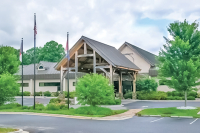Rocking out
Here in the southern mountains there are magical habitats to be explored in every direction and at every elevation. Periglacial boulderfields are among the most unique of these. I learned about them some years ago when I happened upon this description in Charles E. Roe’s A Directory to North Carolina’s Natural Areas (Raleigh: N.C. Natural Heritage Foundation, 1987):
“The final event in the billion-year building of the Appalachian mountains took place about 235 million years ago at the end of the Paleozoic era ... For the past 200 million years the Appalachians have been carved by streams and eroded by the elements. The glacial sheets covering the northern continent during the Pleistocene time did not reach North Carolina. Yet the Southern Appalachians were locally affected by snow and ice packs and frost heaving action; the presence today of boulderfields and polygonal rock patterns attest to that periglacial activity ... The series of boulderfields at the heads of coves on the northeast slopes of Steestachee Bald and Wesner Bald (5,000 to 5,613 feet elevation) are considered to be products of that severe climate. The boulderfields consist of rock blocks up to six feet in diameter, covering areas up to 200 feet wide and 600 feet long.” (Roadside access to these sites can be had between mileposts 437 and 438 along the Blue Ridge Parkway above Balsam Gap.)
Those observations prompted me to take a look at A Roadside Guide to the Geology of the Great Smoky Mountains National Park (Knoxville: Univ. of Tennessee Press, 1988), wherein geologist Harry L. Moore explained that “approximately 20,000 to 16,000 years before the present the mountain peaks of the Smokies had tundra vegetation and had developed permafrost where the mean annual temperatures were below 32 degrees F. In fact, a permanent snowpack may have existed throughout the year in some high hollows. Intense freeze-thaw activity resulted in the development of block fields .... During the time between 16,500 and 12,500 years before the present, there was an increase in mean annual temperature and precipitation. Mass wasting and freeze-thaw action reworked sediments down the unstable mountain slopes.”
Moore noted that periglacial boulderfield sites (also called “block fields” or “block streams”) can be located at the Locust Nature Trail and the Buckeye Nature Trail in the Chimney Tops area on the Tennessee side of the national park alongside U.S. 441.
After reading those accounts (and others in the scientific literature), I set out to explore as many boulderfields as I could locate in the Smokies region of Western North Carolina. What I discovered is that they are just about everywhere in the middle and higher elevations along highways, logging roads, and trails.
Finding one isn’t the problem. But deciding their origin can be vexing. Many are no doubt periglacial relics dating from the Ice Age, especially the more extensive ones in the high Smokies and Great Balsams. Others appear to be naturally-occurring talus slopes at the base of rock outcrops that are still active in some instances.
Related Items
Boulderfields are usually created out of gneissic materials (the granitic, metamorphosed rock that dominates our terrain), but they can be composed of any stone found here. The most colorful one I’ve chanced upon is located along the Jumpup section of the Appalachian Trail above the Nantahala Gorge. It’s composed of chunks and slabs of a lovely blue calcareous material almost pure and hard enough to be marble.
The plant life of a given boulderfield is determined to a great extent by the type of stone found therein. In their Classification of the Natural Communities of North Carolina (Raleigh: North Carolina Natural Heritage Program, 1990), Michael P. Schafale and Alan S. Weakley noted that although boulderfield sites usually occur within the northern hardwood forest type, they are “distinctive enough to be considered a separate type. When well-developed, the aspect of large trees and moss-covered boulders and the distinctive species composition are striking.”
They also pointed out that there are two basic kinds of boulderfields: those with and those without water seeping under or flowing among the rocks. Among the rarer plant species associated with these settings are wolfsbane, mountain watercress, hemlock parsley, spotted mandarin, bent avens, meehania, and Core’s starwort.
Densely compacted inactive boulderfields situated in northeast-facing ravines are almost always carpeted with verdant green beds of moss that often fill in the cracks between individual stones. My favorite sites have creeks flowing underneath them so that they become extremely lush due to the moisture. The moving water far below creates a constant tinkling sound that’s almost like music.
Growing in the moss mats will be various fern species and showy wildflowers. Sites associated with limestone or other calcareous materials can display extensive colonies of wild bleeding heart. A boulderfield situated on the Cherokee Indian Reservation has a colony of walking fern growing on most of the blocks at the head of the site; that is, over 100 colonies of walking fern within a space the size of a football field. The dominant canopy tree of virtually every boulderfield is yellow birch, which has the ability to seed in the moss mats and send its long roots down around the boulders into the soil below.
I once heard a Cherokee stonemason refer to the rocks that he and others extract with considerable difficulty from the high-elevation boulderfields on their lands as “native stone.”
The periglacial boulderfields of the southern Blue Ridge are among the most fascinating and ethereal of the natural areas found here. Visiting them transports you back to a time not so very long ago when our seemingly benign landscape featured alpine tundra, a timberline, enormous snowpacks, and cataclysmic freeze-thaw intervals that fractured high-elevation rock faces into streams of debris.
George Ellison wrote the biographical introductions for the reissues of two Appalachian classics: Horace Kephart’s Our Southern Highlanders and James Mooney’s History, Myths, and Sacred Formulas of the Cherokees. In June 2005, a selection of his Back Then columns was published by The History Press in Charleston as Mountain Passages: Natural and Cultural History of Western North Carolina and the Great Smoky Mountains. Readers can contact him at P.O. Box 1262, Bryson City, N.C., 28713, or at This email address is being protected from spambots. You need JavaScript enabled to view it..









